 Many people are convinced that the use of a suitable toothpaste, the right brush and mouthwash is an absolute guarantee of protection against caries. But most often they overestimate the possibilities of hygiene products for the oral cavity, or make mistakes in their choice.
Many people are convinced that the use of a suitable toothpaste, the right brush and mouthwash is an absolute guarantee of protection against caries. But most often they overestimate the possibilities of hygiene products for the oral cavity, or make mistakes in their choice.
Damage to the tooth surface can be manifested in different ways. Often there are hypoplasia, acid necrosis, wedge-shaped defects. But the most common dental disease is carious lesion.
In the case when the disease was not detected at the stain stage, tooth decay continues at a rapid pace, resulting in the development of superficial caries.
Contents
- Features of the superficial form of the disease
- What provokes the development of the destructive process?
- Manifestations and complaints
- Diagnostic criteria and methods
- Dental care
- Help yourself
- Preventive measures
Features of the superficial form of the disease
As a result of the lesion, the tooth surface becomes demineralized, which leads to its deformation and destruction. Superficial caries chooses a place of its localization tooth enamel, where it is usually well marked. But if you do not give it the proper attention, it will lead to the progress of the destructive process, and the teeth will react sharply to any chemical or mechanical effect.
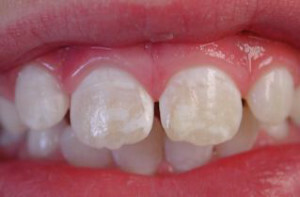
Pain in these cases is of a short duration, but it should be a serious call to visit the dentist. The sooner you seek medical help, the more likely to do without serious problems.
When cavities appear on the tooth enamel, a cavitary defect is formed, with no damage to the dentin tissue. Clinico-morphological classification divides the course of the disease into several stages.
First the stage of the stain develops( the initial caries), after it there is a superficial enamel damage, then the middle one develops and only then the deep caries hits the tooth.
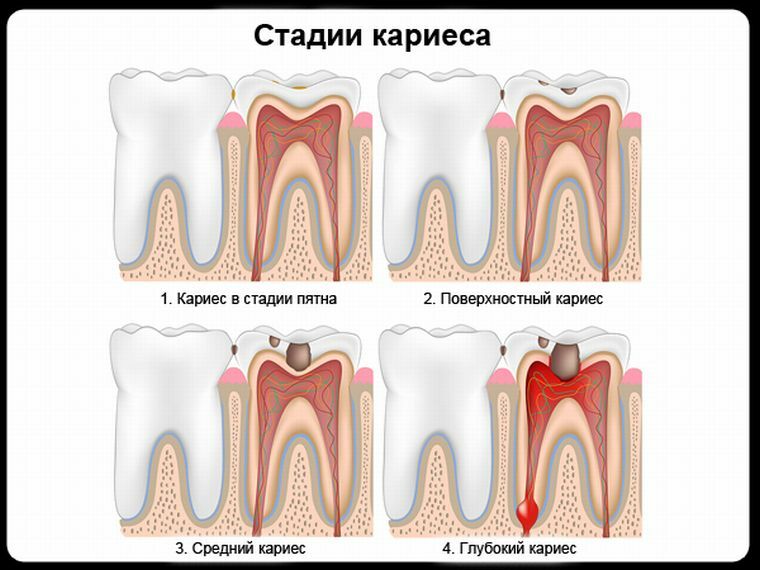
The initial forms are more typical in childhood and adolescence. But the more average and deep forms of the disease most often affects teeth in the adult population.
In Russia, tooth decay is the most common problem in the field of therapeutic dentistry and occurs in 65-95% of the population according to different data.
What triggers the development of a destructive process?
The caries of the enamel in the initial stage has the appearance of a chalk spot with a characteristic unnatural shade. This is the main indicator of the ongoing demineralization in tooth enamel. Externally, the tooth looks without damage, due to the preservation of a flat surface.
Provision of superficial enamel lesions may result in inadequate care of the oral cavity and teeth.
Irregular cleaning of the teeth promotes the accumulation of microorganisms on the teeth, which leads to the formation of plaque. Bacterial deposits on the teeth are the main cause of development of superficial caries and provoke further exacerbation of the disease.
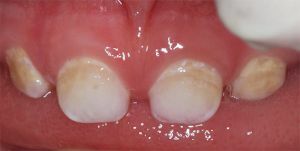
Primary manifestations of superficial caries of infant teeth
In the photo there is a decrease in the level of natural acidity in the oral cavity, which promotes the washing away of useful minerals and calcium from the enamel.
Due to this, the tooth decay gradually begins. The stage of the spot flows into the surface enamel lesion. The destruction of the tooth begins, on which you can see a defect in the form of a pyramid, the top of which is on the border of dentin and enamel.
In some cases, a person may have a hereditary predisposition to thinning of the enamel. This can contribute to the consumption of poor quality water with insufficient fluorine content.
Damage to tooth enamel can occur due to chemical exposure factors:
- features the composition of human saliva;
- lack of minerals and vitamins in the diet.
To cause problems with the health of the teeth may be an incorrect bite, which in time was not subject to the necessary adjustment.
Experts argue that the use of orthodontic structures can also damage the surface of the teeth. Even an inferiorly installed seal carries a great danger. In the cavity under the seal can get food particles, and clean them from there with a brush is simply impossible.
Manifestations and complaints
Superficial caries has a number of fairly vivid symptoms. Of course, at the initial stage of the disease, nothing can be seen except for the spot that appears, but it is only the defeat to move further into the tooth cavity and the person begins to experience a feeling of discomfort, pain when drinking and eating.
The damaged area reacts to sour, sweet, salty. The irritant effect persists with mechanical and thermal  exposures. The pain appears abruptly, lasts a short time and passes very quickly. In some cases, a person generally does not feel any pain.
exposures. The pain appears abruptly, lasts a short time and passes very quickly. In some cases, a person generally does not feel any pain.
The person begins to suspect about the presence of a carious defect in the process of food intake, when food particles are hammered into the formed cavities. In such cases, there is inflammation of the gum in the area adjacent to the damaged tooth. There may be bleeding gums.
The most obvious sign of caries formation is the deformation of the enamel surface, which gradually leads to the destruction of the entire tooth.
Superficial caries originates on a site where there is already a spot stage. Enamel in this place is thinned, subject to further destruction due to increased sensitivity. In the area of the appeared defect, various microorganisms, food remains are accumulated.
Plaque formations quickly mineralize, representing a dental plaque. It is in this place begins the pathological production of acids that destroy the tooth.
Diagnostic criteria and methods
In the early stages, the patient can not independently recognize the disease. Most people think that a white spot on the tooth surface is a simple plaque that must be cleaned. This is the greatest danger.
Damaged enamel may have a different color. This affects the intake of food with the presence in it of certain dyes.
Only a visit to the dentist can reveal the superficial caries even at the stage of its origin, for this different diagnostic measures are carried out. Already on the first examination it is possible to establish the nature and severity of the lesion:
- The first examination - examination reveals the presence of white spots with a chalky hue. But it's still too early to talk about caries.
- If, during the conduct of the probe through the patch spot, failures occur, this indicates the presence of thinned enamel.
- At the next stage, the suspicious areas are painted. For this, special dyes are used.
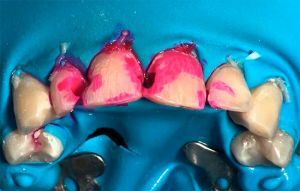 In the field of fissures, it is often possible to observe hidden lesions. In the grooves formed it is very convenient to accumulate bacterial plaque, since these places are considered difficult to access for qualitative purification.
In the field of fissures, it is often possible to observe hidden lesions. In the grooves formed it is very convenient to accumulate bacterial plaque, since these places are considered difficult to access for qualitative purification.
Probing these areas, as a rule, immediately makes it clear that there is a roughness or defect. The examination can be accompanied by a short-term manifestation of pain.
Rendering of dental care
Surface caries treatment is possible using several techniques:
- Without sealing .If the defect is insignificant and the enamel has sufficient density, then the
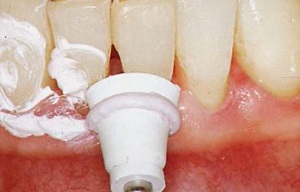 treatment can be performed without sealing. On the surface of the tooth, it is necessary to grind the rough area, then carefully polish it. This method helps to eliminate the possible repetition of the problem. After this, the process of restoring the structure of the enamel from the inside begins. Local fluorination is required.
treatment can be performed without sealing. On the surface of the tooth, it is necessary to grind the rough area, then carefully polish it. This method helps to eliminate the possible repetition of the problem. After this, the process of restoring the structure of the enamel from the inside begins. Local fluorination is required. - Sealing .Superficial caries does not require anesthesia of the damaged area. Unpleasant sensations can appear on the border of dentin with enamel, but they are short-lived and not strong. Dissection takes place fairly quickly and easily. The cavity is filled with a composite material.
- Sealing of hard-to-reach places .In places where access is difficult, the dentist is forced to open access to the defect. For this, it is required to remove a small area of absolutely healthy dental tissue. The method is forced, but it prevents further tooth decay. The filling of teeth is finished with the polishing of the seal itself, after which it is covered with a special lacquer with a high content of fluoride.
Help yourself
Before you start to treat the defect yourself, you need to consult a doctor. The erroneous approach to treatment and prevention significantly distances from professional assistance, and this threatens further serious destruction of teeth.
At home, you can conduct a deep fluoridation of teeth to strengthen the enamel. For this, special drugs are used, which can be bought at pharmacies. This approach will prevent the development of the initial form of the disease, leaving no chance for further progression of the disease. Enamel is quickly restored and acquires sufficient density.
Quality timely treatment guarantees a favorable prognosis. Modern materials for installing seals are very reliable and of high quality.
Consequences can develop if untimely application for professional help. This threatens serious destruction, the formation of medium caries, and as a result of inflammation of the nerve - pulpitis.
Preventive measures
The basis of prevention is proper oral care and timely treatment of primary forms of the disease. If there are any doubtful areas on the tooth surface, you should immediately consult a doctor.
 Then the chances of preventing further development of the defeat are doubled. It is possible to preserve the tooth aesthetic appearance and functionality.
Then the chances of preventing further development of the defeat are doubled. It is possible to preserve the tooth aesthetic appearance and functionality.
The oral cavity needs a full daily care. It is necessary to clean teeth regularly, use special rinse, use calcium-containing vitamins.
It is necessary to visit the dentist once a year for preventive examination. If necessary, conduct professional cleaning of teeth in the clinic. Adhere to a balanced diet, limit carbohydrates, drink less sweet soda water.
